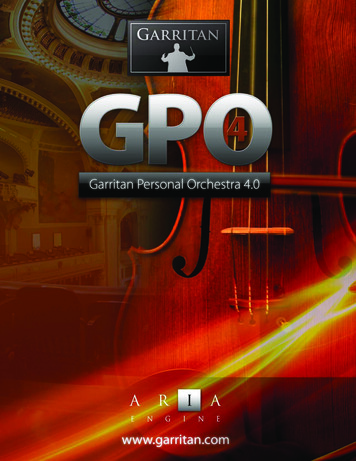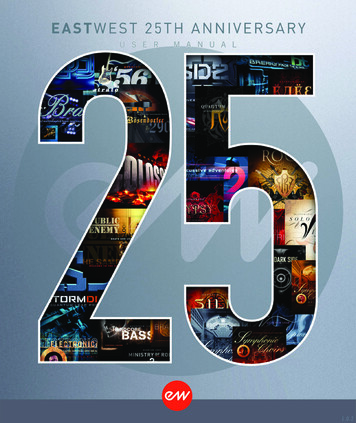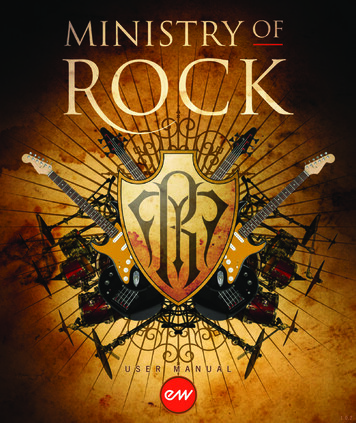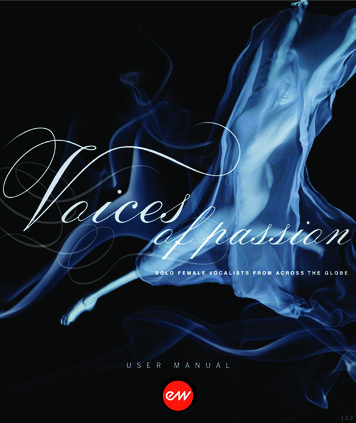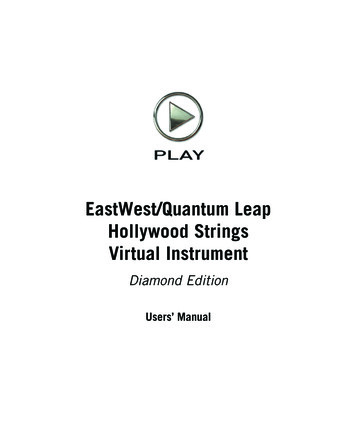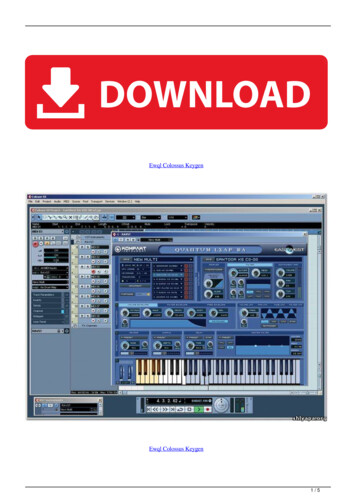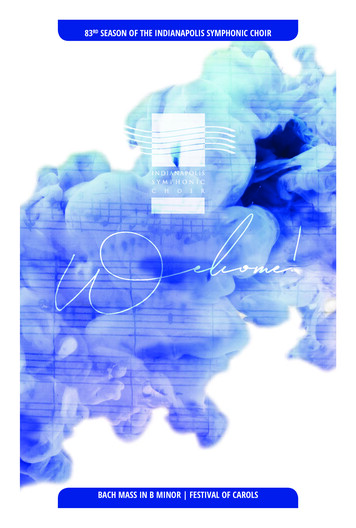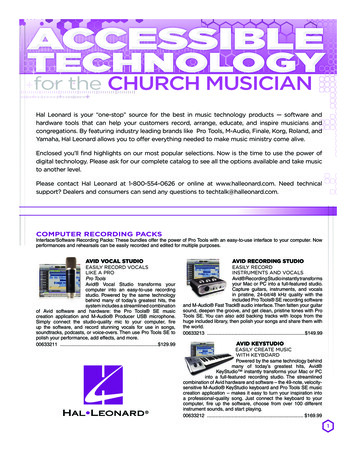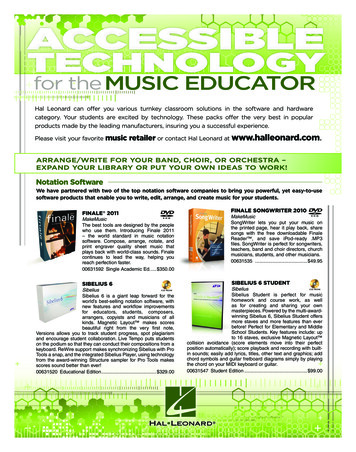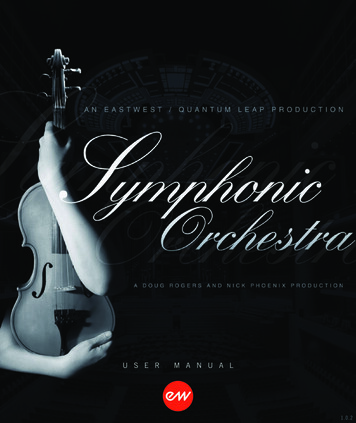
Transcription
U S E RM A N U A L1.0.2
EASTWEST SYMPHONIC ORCHESTRAIMPORTANT COMPATIBILITY NOTE!Our Revolutionary New Opus Software EngineOur brand new Opus software engine has been years in development, and replacesthe Play engine. All EastWest Libraries (with the exception of the original HollywoodOrchestra, the original Hollywood Solo Instruments, and the MIDI Guitar Series) aresupported in Opus, allowing them to take advantage of a faster, more powerful, moreflexible, and better looking software engine.Opus comes with some incredible new features such as individual instrument downloads, customized key-switches, new effects for the mixer page, scalable retina userinterface upgrades for legacy products, a powerful new script language, and many morefeatures that allow you to completely customize the sound of each instrument.It’s one of the most exciting developments in the history of our company and will be thelaunching pad for many exciting new products in the future.Using Opus and Play TogetherOpus and Play are two separate software products, anything you have saved in yourprojects will still load up inside the saved Play version of the plugins. You can updateyour current/existing projects to Opus if you so choose, or leave them saved within Play.After purchasing or upgrading to Opus you do not need to use Play, but it may be moreconvenient to make small adjustments to an older composition in your DAW loading theinstruments saved in Play instead of replacing them with Opus. For any new composition, just use Opus.A Note About User ManualsAll EastWest Libraries have their own user manuals (like this one) that refer to instruments and controls that are specific to their respective libraries, as well as referencingthe Play User Manual for controls that are common to all EastWest Libraries.For EastWest Libraries supported for use within Opus, we highly recommend takingadvantage of all the powerful new features it has to offer.Reference this user manual for details related to the instruments and controls specificto this library and, in place of the previously mentioned Play Software Manual, refer tothe Opus Software Manual from the link below instead.OPUS SOFTWARE MANUAL: tware-Manual.pdfii
EASTWEST SYMPHONIC ORCHESTRAThe information in this document is subject to change without notice and does not represent a commitment on the part of East West Sounds, Inc. The software and soundsdescribed in this document are subject to License Agreements and may not be copiedto other media. No part of this publication may be copied, reproduced or otherwisetransmitted or recorded, for any purpose, without prior written permission by East WestSounds, Inc. All product and company names are or trademarks of their respectiveowners. East West Sounds, Inc., 2008. All rights reserved.East West Sounds, Inc.6000 Sunset Blvd.Hollywood, CA 90028USA1-323-957-6969 voice1-323-957-6966 faxFor questions about licensing of products: licensing@eastwestsounds.comFor more general information about products: .comiii
EASTWEST SYMPHONIC ORCHESTRA1. Welcome2356799About EastWestProducer: Doug RogersProducer: Nick PhoenixRecording Engineer: Prof. Keith O. JohnsonCreditsHow to Use This and the Other ManualsOnline Documentation and Other Resources1
EASTWEST SYMPHONIC ORCHESTRAWelcomeAbout EastWestEastWest (www.soundsonline.com) has been dedicated to perpetual innovation and uncompromising quality, setting the industry standard as the most critically acclaimedproducer of Sample CDs and Virtual (software) Instruments.Founder and producer Doug Rogers has over 30 years experience in the audio industryand is the recipient of many recording industry awards including “Recording Engineer ofthe Year.” In 2005, “The Art of Digital Music” named him one of “56 Visionary Artists &Insiders” in the book of the same name. In 1988, he founded EastWest, the most critically acclaimed sound developer in the world, and recipient of over 50 industry awards,more than any other sound developer. His uncompromising approach to quality, and innovative ideas have enabled EastWest to lead the sound-ware business for 20 years.In 1997 Rogers partnered with producer/composer Nick Phoenix and set up QuantumLeap, a wholly owned division of EastWest, to produce high-quality, no-compromise sample libraries and virtual instruments. Quantum Leap virtual instruments are mostly produced by Nick Phoenix. Some of the larger productions, such as Symphonic Orchestra,Symphonic Choirs and Quantum Leap Pianos are co-produced by Doug Rogers and NickPhoenix. As a composer, Phoenix began scoring film trailers and television commercialsin 1994. To date, he has either scored or licensed music for the ad campaigns of over1000 major motion pictures including Tomb Raider 2, Terminator 3, Lord of the RingsReturn of the King, Harry Potter 2, Star Wars Episode 2, Spiderman 3, Pirates of theCaribbean 3, Blood Diamond, Night at the Museum, and The Da Vinci Code. QuantumLeap has now firmly established itself as one of the world’s top producers of high-endsample libraries and virtual instruments.In 2006, EastWest purchased the legendary Cello Studios (formerly United Western Recorders) on Sunset Boulevard in Hollywood, re-naming it EastWest Studios. The 21,000sq. ft. facility, since remodelled by master designer Philippe Starck, houses five recording studios and is the world headquarters for EastWest.Chapter 1: Welcome2
EASTWEST SYMPHONIC ORCHESTRAProducer: Doug RogersDoug Rogers has over 30 years experience in the audio industry and is the recipient ofmany recording industry awards including “Recording Engineer of the Year.” In 2005,“The Art of Digital Music” named him one of “56 Visionary Artists & Insiders” in the bookof the same name.In 1988, he founded EastWest, the most critically acclaimed sound developer in theworld, and recipient of over 50 industry awards, more than any other sound developer.His uncompromising approach to quality, and innovative ideas have enabled EastWestto lead the sound-ware business for 20 years. In the late eighties, he released the veryfirst commercial drum sample CD, and followed it with the multiple-award-winning “BobClearmountain Drums” sample collection.In the years that followed he practically reinvented the sound-ware industry. EastWestintroduced loop sample libraries to the market in the early nineties, followed closelyby the first midi-driven loops (Dance/Industrial). He released the first sample library toinclude multiple dynamics, followed by the first sample library to stream from hard disk,an innovation that led to the detailed collections available today. His recent productionsof Symphonic Orchestra (awarded a Keyboard Magazine “Key Buy Award,” EQ Magazine “Exceptional Quality Award,” Computer Music Magazine “Performance Award,” andG.A.N.G. [Game Audio Network Guild] “Best Sound Library Award”); and SymphonicChapter 1: Welcome3
EASTWEST SYMPHONIC ORCHESTRAChoirs (awarded Electronic Musician “2006 Editor’s Choice Award,” G.A.N.G. “BestSound Library Award,” and Keyboard Magazine “Key Buy Award”). He persuaded audiolegend Prof. Keith O. Johnson to record EWQLSO and EWQLSC, and came up with therevolutionary idea of recording all instruments and voices with 3 simultaneous stereomic setups so users can control the tone of the performances and the acoustics of theconcert hall, as well as create surround sound mixes.His latest productions include Quantum Leap Pianos, another 3 mic setup, and the mostdetailed virtual piano collection ever produced; and Fab Four, inspired by the soundsof the Beatles, featuring the same kind of vintage instruments and original EMI/AbbeyRoad recording equipment as the Beatles used to create their music. He persuadedaudio legend Ken Scott, who was involved in the recording of five Beatles albums, andengineer for “Magical Mystery Tour” and “The Beatles” (also known as the White Album)to work with him on Fab Four.He also acquired one of Hollywood’s most famous recording studio complexes in 2006,formally United Western (now EastWest Studios), recipient of more engineering awardsand RIAA certified Gold and Platinum recordings than any other studios worldwide. Hepersuaded top international design superstar Philippe Starck to redesign the non-technical areas of the studios. Over the last decade he has partnered with producer/composerNick Phoenix and set up the Quantum Leap imprint, a subsidiary of EastWest, to produce high-quality, no compromise sample libraries and virtual instruments. EastWest/Quantum Leap virtual instruments are considered the best available and are in daily useby the who’s who of the industry.His latest technical achievement was unveiled at the 2007 NAMM convention - theworld’s first 64-bit audio engine named PLAY, which powers EastWest/Quantum Leap’slatest suite of virtual (software) instruments.Chapter 1: Welcome4
EASTWEST SYMPHONIC ORCHESTRAProducer: Nick PhoenixNick began scoring film trailers and television commercials in 1994. To date, he haseither scored or licensed music for the ad campaigns of over 1000 major motion pictures. “Rendition,” “Spider-Man 3,” “Golden Compass.” “The Assassination of JesseJames,” “Pirates of the Caribbean 3,” “Babel,” “Hitman,” “I Am Legend,” “300,” “NoCountry For Old Men,” “Harry Potter 5,” “The Brave One,” “Wall-E,” “Blood Diamond,”“Speed Racer,” and “Night at the Museum” are a few recent examples. Nick and ThomasBer gersen founded the ultimate trailer music company “Two Steps From Hell” in 2006.www.twostepsfromhell.com.Nick has also scored numerous TV shows for NBC, CBS, Showtime, and Fox. “In Pot WeTrust,” a Showtime original film, is playing in the fall of 2007.The journey as a composer has also inspired Nick to record and program his own soundsand samples. Nick founded Quantum Leap Productions in 1997 and Quantum Leap hassince grown to be the world’s top producer of high-end virtual instruments. A 10‑yearpartnership with Doug Rogers and East West has yielded countless award winning software titles such as Stormdrum, Symphonic Orchestra, Symphonic Choirs, RA, Voicesof Passion, Ministry of Rock, Gypsy, QL Pianos, VOTA, QL Brass, QL Guitar and Bass,Hardcore Bass, Goliath, and Colossus.Nick’s studio is located in Venice, California, and is 100% solar powered.www.nickphoenix.comChapter 1: Welcome5
EASTWEST SYMPHONIC ORCHESTRARecording Engineer: Prof. Keith O. JohnsonProf. Keith O. Johnson has spent over 30 years developing a reputation for innovativethinking, technical achievement and musicianship which has elevated him to a positionin the audio industry occupied by only a handful of visionaries. His intensive investigation of electronic behavior and acoustic perception have led most recently to his development (with digital engineer Michael Pflaumer) of the revolutionary High DefinitionCompatible Digital encoding process, produced and marketed by Pacific Microsonics(recently acquired by Microsoft). HDCD is widely considered to be the most accuraterecording process ever invented. His 90-plus recordings have long been considered thestandard for high fidelity, and include three GRAMMY award-winners and eight additional GRAMMY nominations.SOME REVIEWS OF HIS RECORDINGS:“How Johnson got that huge climax at the end of the Dances cleanly onto tape transcends engineering and goes into the realm of magic.” -- Harry Pearson, THE ABSOLUTESOUND.“Keith Johnson’s engineering, mastering and production have, in this case, produced thefinest orchestral recording I have ever heard ” -- Russell Lichter, SOUNDSTAGEChapter 1: Welcome6
EASTWEST SYMPHONIC ORCHESTRACreditsProduced byDoug Rogers and Nick PhoenixRecorded byProf. Keith O. JohnsonCustom Recording Equipment Built and Designed byProf. Keith O. JohnsonAssistant EngineerRhys MoodyConcept byDoug Rogers, Nick Phoenix, and Rhys MoodySample EditingArne Schulze, Nick Phoenix, Claudia Phoenix, Rhys Moody, Justin Harris,Scott Plunkett, Pierre Martin, Charles Fielding, John Hug, Robert Phoenix,Scott Jennings, James Rickabaugh, Pacemaker, Rob Williams, Michael Becker,Jonathan Marmor, Nick Pavey, and Jared SelterSoftwareDoug Rogers, Nick Phoenix, Klaus Voltmer, Klaus Lebkucher, Patrick Stinson,Stefan Kersten, Toine Diepstraten, Thomas Merkle, Sam Fischmann, David Kendall,Nick Cardinal, and Jonathan KranzProgrammingNick Phoenix and Justin HarrisScore and ArticulationsNick PhoenixChapter 1: Welcome7
EASTWEST SYMPHONIC ORCHESTRAPerformance ProgrammingGünter HirscherSurround Looping and Custom Editing ToolsArne SchulzeArt DirectionSteven Gilmore and Doug Rogers (photo by Mike Itashiri)ManualJohn PhilpitSpecial ThanksAll of the musicians (we salute you!) and all at EastWestChapter 1: Welcome8
EASTWEST SYMPHONIC ORCHESTRAHow to Use This and the Other ManualsAll documentation for the EastWest PLAY Advanced Sample System and its libraries isprovided as a collection of Adobe Acrobat files, also called PDFs. They can be viewed onthe computer screen or printed to paper.Each time you install one of the PLAY System libraries, two manuals are copied to thefile system on your computer: The manual that describes the whole PLAY System. This, the largest of the manuals,addresses how to install and use all aspects of the software that are common to alllibraries. Anything you cannot find in this manual is likely to be covered in the PLAYSystem manual. The library-specific manual, such as the one you are currently reading. This documentdescribes aspects that differ from one library to the next, such as the list of includedinstruments and articulations as well as some of the controls in the user interface.Using the Adobe Acrobat FeaturesBy opening the Bookmarks pane along the left edge of the Adobe Acrobat Reader, theuser can jump directly to a topic from the section names. Note that some older versionsof Acrobat Reader might not support all these features. The latest Acrobat Reader canbe downloaded and installed at no cost from the Adobe web site. (As an example of ahyperlink, you can click on the last word of the previous sentence to be taken directly tothe Adobe site.)When reading this and other manuals on the computer screen, you can zoom in to seemore detail in the images or zoom out to see more of the page at once. If an includedpicture of the user interface, or a diagram, seems fuzzy or illegible, then zoom in usingone of several means provided in the Acrobat Reader software. Images from the computer screen are clearest at a zoom of 200%.Online Documentation and Other ResourcesFor the most up to date information, visit the support pages at EastWest’s web site.There you can find: information made available after these manuals were written FAQ pages that may already list answers to questions you have suggestions from EastWest and other users of the EastWest PLAY System news about upcoming releasesThe address is:http://support.soundsonline.comChapter 1: Welcome9
EASTWEST SYMPHONIC ORCHESTRA2. EastWest/Quantum Leap Symphonic Orchestra,An Overview111316161617The Design Point for Symphonic OrchestraThe Four Editions of Symphonic OrchestraSymphonic Choirs, a Companion LibraryWhat’s IncludedHardware RequirementsLibrary-Specific Installation Instructions for Symphonic Orchestra10
EASTWEST SYMPHONIC ORCHESTRAEastWest/Quantum Leap Symphonic Orchestra,An OverviewThe Design Point for Symphonic OrchestraThe original EastWest/Quantum Leap Symphonic Orchestra library was the result of yearsof planning, scoring, recording, editing, and programming by over 100 creative professionals. And the “Professional XP” expansion pack took another 3 years total, 2 of themin post-production, approximately doubling the number of available articulations. Now,after several more years of planning and hard work, we are proud to present the latestversion of Symphonic Orchestra, one that takes advantage of our own PLAY AdvancedSample Engine. Through all the versions we have kept to our original goal to create a fullorchestral sample library, one that can be used to create recordings in surround sound,will blend perfectly with EastWest/Quantum Leap Symphonic Choirs, and all recordedwhere orchestras and choirs sound most natural, in a “state of the art” concert hall.First, we had to find the right team to execute the plan. To capture the sounds, weneeded someone with an impressive history of recording choirs and orchestras live. Theanswer was Prof. Keith O. Johnson. His 90-plus recordings have long been consideredthe standard for high fidelity, and include three GRAMMY award-winners and eight additional GRAMMY nominations. All of the recording equipment used in the project waseither hand-built or extensively modified by him to optimize fidelity.Next, we had to find the right concert hall in which to record EWQLSO and EWQLSC.Fortunately, his experience was invaluable here as well. He had recorded in most of the“critically acclaimed” concert halls throughout the world, and had a short list of favorites. It’s extremely difficult to book a popular concert hall for weeks at a time, but wemanaged to do it during the resident orchestra’s summer breaks. Needless to say, theorchestra missed some summer vacation, because they were working on this project.After the recording was completed, the post-production team was put to work, whichincluded some of the finest sound designers and programmers in the business. Specialsoftware was developed to edit the multiple tracks simultaneously, and keep them inphase. Nearly a year of post-production was necessary to achieve the final result—a result we are all extremely proud of.To date, the EastWest/Quantum Leap Symphonic Orchestra has received more awardsthan any other orchestral library ever created!The decision by the EastWest/Quantum Leap team to design its own sample player, thePLAY Advanced Sample Engine, provided an opportunity to improve on an already im-Chapter 2: EastWest/Quantum Leap Symphonic Orchestra, An Overview11
EASTWEST SYMPHONIC ORCHESTRApressive range of features. Just of a few of the new EWQLSO-specific features made possible in the PLAY version are performance scripts, full integration of the original and ProXP libraries, on-screen mixing of the three microphones (Platinum and Platinum Plusonly), a more intelligent release trails engine, and the availability of larger and more flexible keyswitches. And the whole collection of samples has been reprogrammed to takeadvantage of the new PLAY engine. If you’re upgrading from an earlier version, be sureto read carefully both this manual and the PLAY System manual to find out how to usethe many new features.We hope you enjoy this latest incarnation of the EastWest Quantum Leap SymphonicOrchestra Virtual Instrument as much as we do—and we would love to hear what youcreate with it.Technical Details of the RecordingsEach instrument sample contains high-resolution components recorded from microphonegroups placed to achieve close, full, and ambient sound. Setups are modeled after traditional Decca setups (see below) having front omnidirectional microphones for full stringsound, a directional center tree to focus woodwinds and brass and a number of stereopair accents for solo and close up work. Instruments are placed on stage where they usually perform so that signals from these microphone groups can be mixed and have thegeneral technical feel and acoustic properties of a live session. Soloists can be broughtforward, other instruments can be accented yet remain back or in the orchestra, and offstage effects can be produced, all with correct acoustic perspective.Advanced: A “Decca tree”—for those interest-ed—is an arrangement of three microphonesoriginally designed at the English Decca Records, and still used for orchestra recordings,especially when recording movie scores. Themics are arranged as in the diagram at the right.Because of the 2-meter spacing between theleft and right mics, the audio provides the intensity cues necessary for detailed stereo imagingwhile including sufficient phase information toproduce an open and spacious sound. In addition, the middle microphone generates a solidcentral image.A lot of post-production work and active DSP is mandatory to align the multiple timephase paths from each of the sample groups. In addition, a large concert space was required to avoid claustrophobic wall sounds and to capture the instrument sound we hearat an appropriate distance. These ultimately achieve overall clarity in the mix.To provide process headroom for this work, a super-resolution recording chain was used.FM microphone responses extended to at least 26 kHz, all signal paths had minimaldiscrete circuit electronics, plus conversions and files were at least 24-bit 88.2kHz. (WeChapter 2: EastWest/Quantum Leap Symphonic Orchestra, An Overview12
EASTWEST SYMPHONIC ORCHESTRAalso recorded everything at 176.4kHz for future updates.) All these Gigabytes of dataare needed to capture the sounds of instruments from different angles, placements, anddistances. The six-channel high-resolution files containing close, full, and reverberantfeeds can produce a real 3D orchestral sense like that from a good concert hall recording. To do this, simplified user commands or presetable instrument placements replacedoutmoded pan and gain control functions. The new controls make complex adjustment ofdirect to reflected sound, time-phase relationships and equalizations in order to track aninstrument’s placement. In this manner, an instrument can be accented within a group,brought forward as a soloist, or moved off stage; and the acoustic sound will correlate.The Orchestral Sound When Using the 3 Microphone Positions in PlatinumSonic perspective, i.e., close or distant sound experience, has been important during theevolution of musical instruments. Crafts people develop their sound in the close environsof their shop or studio, but composers and listeners perceive and expect instrumentsto work properly in an acoustic space. Both aspects must be sampled and reproducedcorrectly because a listener can focus or hone in on a direct sound from one instrumentwhen placed amongst others. Feedback mechanisms involved with human hearing subordinate the other sounds so they are perceived either as diffused or as an ensemble.When we can see an instrument, this sensitizing feedback, or “cocktail party hearingacuity” is quick and effective. It works for a live concert experience but not for a recording made from the “best seat in the house.” Without visual connection, a microphoneplaced there will capture a diffuse “whole” sound. One can have exact speaker placements in a symmetrical room and meditate on the experience to focus in but generallysome form of spoon-feeding is required.A good recording setup often requires a close mic accent pickup to jump-start this focused perception. Once used, the accent is often removed, as only a few of these spotsare effective at any one time. Sometimes, a reverberation pickup is added or increased torestore a correct sense of hall response to instrument power. Generally, a good recordingsetup for an orchestra has accent capability and will be much like the early big soundDecca setups described above. Combinations of phase interferences, sonic bleeds tomicrophones, time arrivals, and special energy convey a “best seat” perceptual experience even though the microphones are much closer to the musicians than is the listenerin the hall. The sense of instrument directionality and its effect on stage and hall soundis all possible when using the three microphone positions in the Platinum and PlatinumPlus editions of EastWest/Quantum Leap Symphonic Orchestra.The Four Editions of Symphonic OrchestraBecause not everyone needs all the features with which this library was recorded, thelicense to EWQLSO Virtual Instrument is offered in four different editions at differentprices.Chapter 2: EastWest/Quantum Leap Symphonic Orchestra, An Overview13
EASTWEST SYMPHONIC ORCHESTRAThe editions differ as follows: Silver provides a limited selection of articulations with a single microphone positionplus 16-bit samples. See the tables of the articulations, starting on page 43, to seewhich articulation files are included in Silver. Gold provides all the listed articulations with a single microphone position plus 16-bitsamples. Platinum provides all the listed articulations with three microphone positions plus 24bit samples. Platinum Plus provides all the listed articulations with three microphone positions plusboth 16- and 24-bit samples.In every other way, the four editions are identical. The following table highlights the differences among the four editions of EastWest/Quantum Leap Symphonic Orchestra.SilverGoldPlatinumPlatinum PlusMicrophone PositionsCloseStageSurround Bit Depth16 bit 24 bit Every listedarticulation Silver Edition: PLAY Version Compared to the OriginalThe new Silver Edition is closer in its approach to the new Gold than was true with theoriginal Silver. Three very significant changes relate to chromatic sampling, release trails,and the use of keyswitches. In the original Silver, samples were “stretched,” meaning that samples for some noteswere intentionally not available on the hard drive, so the sample player automaticallytransposed available notes by a semitone or two to create the missing notes. (Thisapproach meant that the amount of storage on the hard drive could be reduced significantly.) In the PLAY version, all notes are directly available as samples, so no suchstretching occurs. The original Silver did not include release trails. The PLAY version does include themfor a more natural ambience. The PLAY version of Silver provides a selection of keyswitches that are similar in function to those in Gold and Platinum. Silver edition no longer uses the “Legato-Pedal”keyswitches of the earlier versions.The result of this different approach to Silver is that the user gets an experience muchcloser to Gold, including the trademark EWQLSO sound. It also means that Silver userswho upgrade to Gold get its much greater range of articulations without having to restartprojects begun with Silver.Chapter 2: EastWest/Quantum Leap Symphonic Orchestra, An Overview14
EASTWEST SYMPHONIC ORCHESTRAOver all, Silver is now identical to Gold but with fewer articulations available.LicensingGold and Silver each include a single license that allows you to use the library on a singlecomputer at a time. If you want to run EWQLSO on more than one computer at once,contact EastWest about obtaining additional licenses.Platinum users receive 4 licenses, one for each orchestral section: strings, woodwinds,brass, percussion. This allows the user to install the different sections on up to 4 separate computers by loading the licenses into separate iLok keys. Those with projects largeenough to require more computers, should contact EastWest about obtaining additionallicenses.Platinum Plus users receive the same 4 licenses mentioned above and also 4 additionallicenses (Strings Plus, Woodwinds Plus, etc.) that provide access to the Plus-specificcontent. If, for example, you are running Platinum Plus on a single computer, it is necessary to install all 8 licenses in a single iLok.The corresponding licenses for Platinum and Platinum Plus must be installed on thesame computer: for example, the licenses for Brass Platinum and Brass Platinum Plus.Therefore, the maximum number of computers for a single installation of Platinum Plusis still 4, unless additional licenses are purchased.Microphone PositionsWhen the producers recorded the live orchestral instruments, the audio was capturedsimultaneously from three groups of microphones. The Platinum and Platinum Pluspackages include samples from all three mic positions. The Silver and Gold packagescontains samples from only one of the mic positions. See the section starting on page113 for more details, including recommendations on how Platinum and Platinum Plususers can take advantage of these extra microphone positions.Bit DepthThe samples from the recording sessions are available in both 16-bit and 24-bit audio.While creating audio output from 24-bit samples can provide a more detailed mix (evenwhen the audio file ends up on 16-bit media, such as a CD), the process of workingwith 24-bit audio can make greater demands on the hardware and software. The threeEWQLSO editions address this trade-off.Gold and Silver are designed for those users for whom the subtle advantages of 24-bitmixing are not as important and who will be writing the output to 16-bit media.Platinum is designed for those users who have computers capable of handling the greaterload of 24-bit processing, and/or will be writing to 24-bit media (such as DVDs).Platinum Plus gives users the ability to work in either environment, as needed. That includes the trick of composing and auditing with 16-bit samples and then quickly chang-Chapter 2: EastWest/Quantum Leap Symphonic Orchestra, An Overview15
EASTWEST SYMPHONIC ORCHESTRAing to 24-bit samples when mixing down the final output. In this way, you can build a16-bit score that might cause problems on your hardware with 24-bit samples and thenrender the final audio output in 24-bit by rendering only a fraction of the tracks at atime and then mixing all of these “frozen” tracks into the total mix at the end. See thedocumentation for your sequencer about how to “freeze” tracks.Symphonic Choirs, a Companion LibraryThe EastWest/Quantum Leap Symphonic Choirs Virtual Instrument (EWQLSC) extendsEWQLSO to include choral samples. Because Symphonic Choirs was recorded in thesame concert hall using the same recording equipment and engineers, it blends perfectlywith Symphonic Orchestra.EWQLSC breaks new ground with its WordBuilder technology that allows the user to create choral text through a simple-to-use gr
duced by Nick Phoenix. Some of the larger productions, such as Symphonic Orchestra, Symphonic Choirs and Quantum Leap Pianos are co-produced by Doug Rogers and Nick Phoenix. As a composer, Phoenix began scoring film trailers and television commercials in 1994. To date, he has either scored or licensed music for the ad campaigns of over
![Ewql Symphonic Orchestra Gold Full [PATCHED]](/img/66/talemm.jpg)
